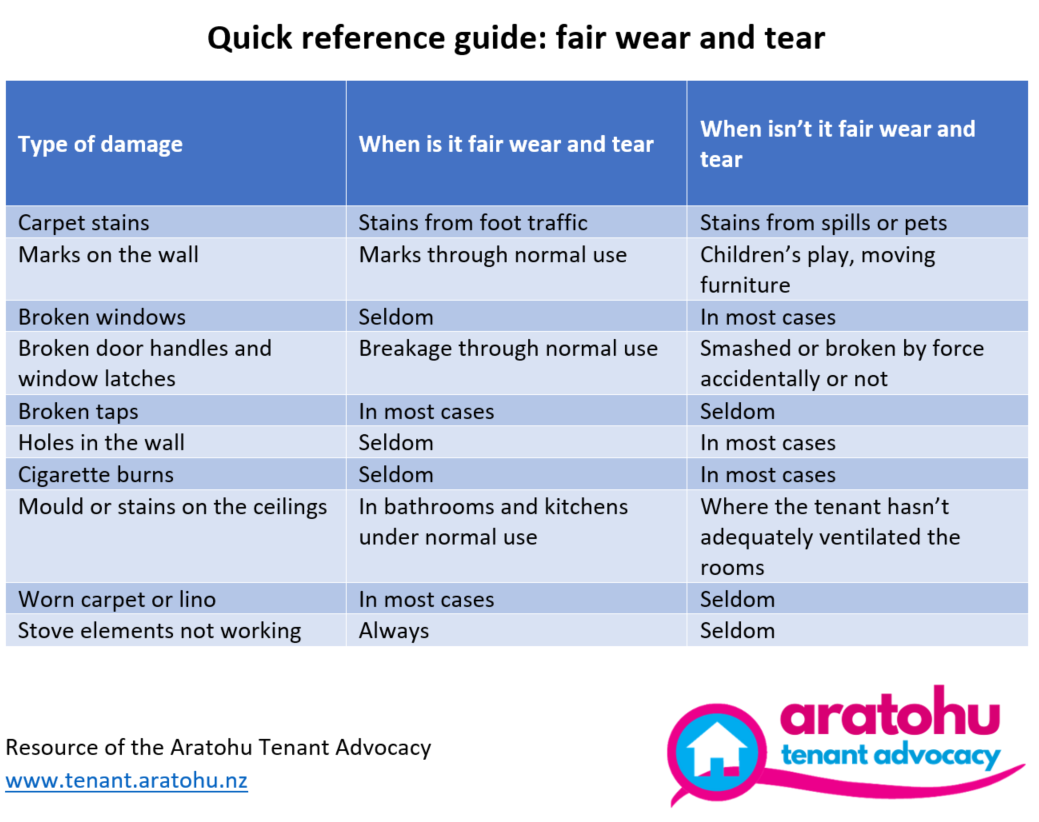Fair wear and tear is the normal ageing and deterioration of things that happens over time when people live in a property. The landlord is responsible for addressing fair wear and tear (s 49A(2) RTA).
Fair wear and tear is sometimes gradual (eg, carpets wearing thin), but it can also be minor damage from everyday activities (eg, scuff marks on walls), or old things wearing out (eg, door handles, stove elements or tap washers).
Fair wear and tear doesn’t include things like children drawing on wallpaper, and damage caused when something is used in a way it wasn't intended (eg, using the stove to heat a room).
See the table below for an overview of what is normally fair wear and tear and what isn’t.
What if there’s a dispute about fair wear and tear?
At the end of a tenancy, there can often be disputes about what is fair wear and tear and what is careless or intentional damage by the tenant.
The law is clear on three things about fair wear and tear:
- Damage due to fair wear and tear cannot be the result of intentional or careless actions by the tenant or their guests.
- Fair wear and tear should relate to the normal and permitted activities of the tenant during the time they lived in the property.
- It’s the landlord’s responsibility to prove that particular damage is not the result of fair wear and tear. On the other hand, it is for the tenant to prove that the damage was not caused intentionally, or by their carelessness, or imprisonable activities, or by other activities that are a breach of the tenancy agreement (e.g. keeping pets without permission or having more people in the flat than the tenancy agreement allows).
Landlord claiming bond money for wear and tear
Some landlords might inappropriately try to make tenants pay for fair wear and tear by claiming some or all of the bond when the tenancy ends.
If the tenant doesn’t challenge this by also claiming the bond, it is likely that the landlord will receive the bond.
Quick tip
Sometimes a landlord may claim the bond to pay for cleaning of carpets or the repainting of ceilings that are badly stained by smoke or mould. The tenant will usually have to pay for these costs unless they can prove that the property was in a similar condition at the start of the tenancy. This shows the importance of completing a full property inspection report at the start of the tenancy.
How to avoid paying for wear and tear
Start off right
Tenants should make sure the property is clean, tidy and not in need of any repairs before they move in.
Complete a property inspection report and have the landlord sign it at the same time as the tenancy agreement is signed.
If there is cleaning to be done and the tenant is prepared to do it, make sure this is noted on the property inspection report. The tenant is only required to leave the place in the same condition as it was when they shifted in, minus fair wear and tear.
Look after the house or flat
Tenants should keep the property clean and tidy, and tell the landlord about any repairs that need doing as soon as possible.
They should keep a record of the repairs and work they have asked to have done and what has been done by the landlord. It may be useful later on if there is a dispute.
Apply for the bond back
Unless a tenant knows they owe the landlord for unpaid rent or damage they have caused, they should apply for the bond back when they shift out.

